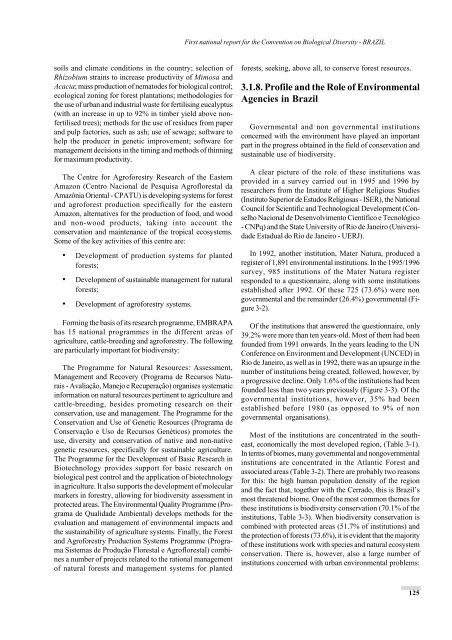Brazil (Part VIII, English version) - Convention on Biological Diversity
Brazil (Part VIII, English version) - Convention on Biological Diversity
Brazil (Part VIII, English version) - Convention on Biological Diversity
- No tags were found...
You also want an ePaper? Increase the reach of your titles
YUMPU automatically turns print PDFs into web optimized ePapers that Google loves.
First nati<strong>on</strong>al report for the <str<strong>on</strong>g>C<strong>on</strong>venti<strong>on</strong></str<strong>on</strong>g> <strong>on</strong> <strong>Biological</strong> <strong>Diversity</strong> - BRAZILsoils and climate c<strong>on</strong>diti<strong>on</strong>s in the country; selecti<strong>on</strong> ofRhizobium strains to increase productivity of Mimosa andAcacia; mass producti<strong>on</strong> of nematodes for biological c<strong>on</strong>trol;ecological z<strong>on</strong>ing for forest plantati<strong>on</strong>s; methodologies forthe use of urban and industrial waste for fertilising eucalyptus(with an increase in up to 92% in timber yield above n<strong>on</strong>fertilisedtrees); methods for the use of residues from paperand pulp factories, such as ash; use of sewage; software tohelp the producer in genetic improvement; software formanagement decisi<strong>on</strong>s in the timing and methods of thinningfor maximum productivity.The Centre for Agroforestry Research of the EasternAmaz<strong>on</strong> (Centro Naci<strong>on</strong>al de Pesquisa Agroflorestal daAmazônia Oriental - CPATU) is developing systems for forestand agroforest producti<strong>on</strong> specifically for the easternAmaz<strong>on</strong>, alternatives for the producti<strong>on</strong> of food, and woodand n<strong>on</strong>-wood products, taking into account thec<strong>on</strong>servati<strong>on</strong> and maintenance of the tropical ecosystems.Some of the key activities of this centre are:• Development of producti<strong>on</strong> systems for plantedforests;• Development of sustainable management for naturalforests;• Development of agroforestry systems.Forming the basis of its research programme, EMBRAPAhas 15 nati<strong>on</strong>al programmes in the different areas ofagriculture, cattle-breeding and agroforestry. The followingare particularly important for biodiversity:The Programme for Natural Resources: Assessment,Management and Recovery (Programa de Recursos Naturais- Avaliação, Manejo e Recuperação) organises systematicinformati<strong>on</strong> <strong>on</strong> natural resources pertinent to agriculture andcattle-breeding, besides promoting research <strong>on</strong> theirc<strong>on</strong>servati<strong>on</strong>, use and management. The Programme for theC<strong>on</strong>servati<strong>on</strong> and Use of Genetic Resources (Programa deC<strong>on</strong>servação e Uso de Recursos Genéticos) promotes theuse, diversity and c<strong>on</strong>servati<strong>on</strong> of native and n<strong>on</strong>-nativegenetic resources, specifically for sustainable agriculture.The Programme for the Development of Basic Research inBiotechnology provides support for basic research <strong>on</strong>biological pest c<strong>on</strong>trol and the applicati<strong>on</strong> of biotechnologyin agriculture. It also supports the development of molecularmarkers in forestry, allowing for biodiversity assessment inprotected areas. The Envir<strong>on</strong>mental Quality Programme (Programade Qualidade Ambiental) develops methods for theevaluati<strong>on</strong> and management of envir<strong>on</strong>mental impacts andthe sustainability of agriculture systems. Finally, the Forestand Agroforestry Producti<strong>on</strong> Systems Programme (ProgramaSistemas de Produção Florestal e Agroflorestal) combinesa number of projects related to the rati<strong>on</strong>al managementof natural forests and management systems for plantedforests, seeking, above all, to c<strong>on</strong>serve forest resources.3.1.8. Profile and the Role of Envir<strong>on</strong>mentalAgencies in <str<strong>on</strong>g>Brazil</str<strong>on</strong>g>Governmental and n<strong>on</strong> governmental instituti<strong>on</strong>sc<strong>on</strong>cerned with the envir<strong>on</strong>ment have played an importantpart in the progress obtained in the field of c<strong>on</strong>servati<strong>on</strong> andsustainable use of biodiversity.A clear picture of the role of these instituti<strong>on</strong>s wasprovided in a survey carried out in 1995 and 1996 byresearchers from the Institute of Higher Religious Studies(Instituto Superior de Estudos Religiosas - ISER), the Nati<strong>on</strong>alCouncil for Scientific and Technological Development (C<strong>on</strong>selhoNaci<strong>on</strong>al de Desenvolvimento Científico e Tecnológico- CNPq) and the State University of Rio de Janeiro (UniversidadeEstadual do Rio de Janeiro - UERJ).In 1992, another instituti<strong>on</strong>, Mater Natura, produced aregister of 1,891 envir<strong>on</strong>mental instituti<strong>on</strong>s. In the 1995/1996survey, 985 instituti<strong>on</strong>s of the Mater Natura registerresp<strong>on</strong>ded to a questi<strong>on</strong>naire, al<strong>on</strong>g with some instituti<strong>on</strong>sestablished after 1992. Of these 725 (73.6%) were n<strong>on</strong>governmental and the remainder (26.4%) governmental (Figure3-2).Of the instituti<strong>on</strong>s that answered the questi<strong>on</strong>naire, <strong>on</strong>ly39.2% were more than ten years-old. Most of them had beenfounded from 1991 <strong>on</strong>wards. In the years leading to the UNC<strong>on</strong>ference <strong>on</strong> Envir<strong>on</strong>ment and Development (UNCED) inRio de Janeiro, as well as in 1992, there was an upsurge in thenumber of instituti<strong>on</strong>s being created, followed, however, bya progressive decline. Only 1.6% of the instituti<strong>on</strong>s had beenfounded less than two years previously (Figure 3-3). Of thegovernmental instituti<strong>on</strong>s, however, 35% had beenestablished before 1980 (as opposed to 9% of n<strong>on</strong>governmental organisati<strong>on</strong>s).Most of the instituti<strong>on</strong>s are c<strong>on</strong>centrated in the southeast,ec<strong>on</strong>omically the most developed regi<strong>on</strong>, (Table 3-1).In terms of biomes, many governmental and n<strong>on</strong>governmentalinstituti<strong>on</strong>s are c<strong>on</strong>centrated in the Atlantic Forest andassociated areas (Table 3-2). There are probably two reas<strong>on</strong>sfor this: the high human populati<strong>on</strong> density of the regi<strong>on</strong>and the fact that, together with the Cerrado, this is <str<strong>on</strong>g>Brazil</str<strong>on</strong>g>’smost threatened biome. One of the most comm<strong>on</strong> themes forthese instituti<strong>on</strong>s is biodiversity c<strong>on</strong>servati<strong>on</strong> (70.1% of theinstituti<strong>on</strong>s, Table 3-3). When biodiversity c<strong>on</strong>servati<strong>on</strong> iscombined with protected areas (51.7% of instituti<strong>on</strong>s) andthe protecti<strong>on</strong> of forests (73.6%), it is evident that the majorityof these instituti<strong>on</strong>s work with species and natural ecosystemc<strong>on</strong>servati<strong>on</strong>. There is, however, also a large number ofinstituti<strong>on</strong>s c<strong>on</strong>cerned with urban envir<strong>on</strong>mental problems:125
















